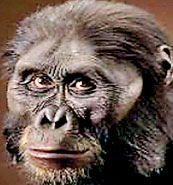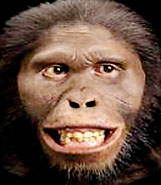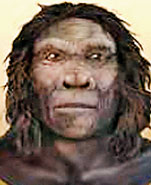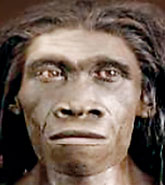Charles Darwin’s ground breaking treatise Origin of the Species published in 1859, was considered by the National Academy of Science as one of the most important scientific discoveries to this day. Basically he said that in the struggle for life the fittest survive and pass qualities needed for survival to the progeny – commonly referred to as the ‘survival of the fittest’. This is very much against the belief that God created human beings, pretty much in their present form. Theologians promptly labelled Charles Darwin the most dangerous man alive in England.
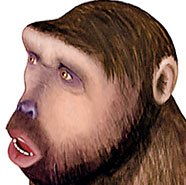 |
| Kenya man, 6 m years ago |
|
| Australopithecas Afarensis. 3 m years ago |
|
| Australopithecas Africanus 2 m years ago |
|
| Home habilis 2.4-1.4 m years ago |
|
| Home erectus 1.9-140,000 years ago |
Charles Darwin, a 22-year-old Cambridge graduate in Natural Sciences, made many of the relevant observations on the South American segment of his voyage on HMS Beagle. While some of his observations were on living animals, others were on fossils. Darwin is almost silent on the evolution or origin of the nervous system. This is mainly because the nervous system (brain, spinal cord and nerves) is soft and does not fossilize.
Abundance of fossils in the East
coast of South America
To understand the reason for the discovery of so many fossils of extinct animals, we have to go back millions of years.
300-400 million years ago, Africa was hugging South America like two congruent triangles. When we see them about 100-150 million years later, they have moved far apart, and Falkland island has rotated 180 degrees.
The reason for the separation is hypothesised to be due to movement of tectonic plates. When tectonic plates in the depths of the ocean move they can cause massive damage on land. The tsunami we experienced on December 26, 2004 was due to the movement of the Indian plate. The Indian plate which usually moves 6 cm per year moved 15 metres at once and produced devastation on land. You can imagine the force required to move continents apart and what would have happened to animal life on land.
Another theory explaining annihilation of the dinosaurs is that it was due to the meteoric crash causing the Chicxulub crater. The space rock was the size of Mount Everest and when it hit Mexico the tail was still 35,000 feet up.
The continents had already separated 150-200 million years ago but the dinosaurs became extinct only 65 million years ago. So we have only theories to explain the extinction of animals of the Jurassic period. The massive animals belonging to the Jurassic era all perished. The largest collection of dinosaur skeletons is found in the paleontology museum of Punta Tombo, on the Eastern coast of Argentina in South America.
Unfortunately we have no clue as to the nervous system of these extinct animals as it does not fossilize.
Primitive nervous systems
So let me trace the nervous system from lowly animals to the present day.
All animals need a nervous system for
(i) detecting and identifying suitable food
(ii) early detection of threats and remedial action.
Even the single-celled amoeba, is sensitive to the environment. It moves away from light, though it has no photo- detectors or eyes. The paramecium, another single-celled animal, has no specialized sensory structures, but, it can avoid cold and heat.
Invertebrate nervous system
Approximately 99% of the world's animals are invertebrates, the largest being the giant squid which can grow up to 18 m (59 ft) long and weigh up to 900 kg (1,980 lb).
The star fish has a basic nervous system with a nerve net and radial nerves passing into each ‘limb’ of the star. The octopus, has the most complicated brain of all the invertebrates- estimated to have 300 million neurons. These neurons are arranged in lobes and tracts that are more specialized than ganglia. An octopus has a "good" memory and can also learn, which prompted some enterprising individuals to use an octopus to predict the results of the football World Cup a few years ago.
Nervous system of vertebrates
In vertebrates we come across a brain with areas developed according to needs. Fish have prominent optic lobes(for vision), frogs and reptiles have sizeable optic and olfactory lobes (for smell). Birds have a good balance system in addition to good vision, while mammals show an improvement of the cerebral hemispheres. Crocodiles which float in the water with only their nostrils and eyes above the surface of water, have developed an acute sense of smell and have large olfactory lobes.
Does brain size matter?
It is not the actual weight of the brain that matters but its proportion to the body weight. Additionally, the convolutions of the brain – the sulci and gyri, matter. Human foetus brains have a smooth surface until 6 months, developing convolutions before birth. Chimps and dolphins too have convoluted brains. The largest brains belong to the blue whale and the elephant. However, the 6 kg brain is only 0.01% of body weight, whereas the human brain of 1300-1500 gms is 1.09% of the body weight. Carnivores, like the lions, have bigger brains in relation to their body size than their prey, which presumably gives them the advantage to create tactics and strategies to catch prey.
Our closest cousins are the Bonobo chimps, which have pincer grips in both the hands and feet, and the brain is a lookalike of the human brain. Orphaned infant chimpanzees that received attentive, nurturing care from human surrogate mothers were found to be more intellectually advanced than the average human baby when both groups were compared at the age of nine months!
Our fossilized ancestors
Let us go back about six million years to the Kenya man - the common ancestor of chimp and man - both of whom had a larynx that repositions during the first two years of life to a spot between the pharynx and the lungs, considered to be an important precursor of speech.
Australopithecus Afarensis of 3 milion years and Australopithecus Africanus of2 M years ago resemble the apes more than humans.
It is when we come to Homo habilis 2.4 – 1.4 million years ago and Homo erectus 1.9 million to 140,000 years ago that we find a recognizable similarity to humans.
Most of them lived in Africa and the migration to Europe and Asia occurred later.
Homo erectus (1.9 M – 143,000 years ago )
Homo erectus has a striking resemblance to modern humans. The brain is only 74% of the size of modern brain and probably branched off from their common ancestor with chimpanzees about 5–7 million years ago.
Balangoda man – 30 -500,000 years ago
The Balangoda man is supposed to be our representative of Homo erectus! The height was about 174 cm for males and 166 cm for females. They had thick skull-bones, prominent brow-ridges, depressed noses, heavy jaws and short necks. Tools have been found as early as 31,000 years at Batadombalena and 28,000 – 30,000 years ago in Bundala and Belilena.
It is claimed that Balangoda man may have ‘created’ Horton Plains, by burning the trees in order to catch game, and also grown oats and barley on the plains dating to about 15,000 yrs. It is conjectured that they may have kept domestic dogs for driving game, and domesticated jungle fowl, pig and water buffalo. A fossil skull of Balangoda man is found in the National Museum in Colombo.
Homo Neanderthalensis (Neanderthal man)
The Neanderthal man that lived 200,000-28,000 years ago was long considered to be our ancestor but mitochondrial DNA have shown that Neanderthals are not our ancestors and are ‘very un-human’. In fact, in the Smithsonian Institute of Natural History, you could have your photograph created as a Neanderthal man.
The immediate ancestor of Homo Sapiens is not known with certainty but there probably was a Homo Neanderthal homo sapiens at the end of the Ice Age, who was short in stature averaging about 5'5". His brain was larger than modern humans, and they probably used tools, with pointed tips. The burial of the deceased was also a trend found in various grounds for the first time and pollen remains were found with many of the bodies, which hints that flowers may have been buried along with the bodies;
When and why did we start
walking on two legs?
An animal can run faster on two legs than on four – the short bursts of speed by a cheetah excepted. A 2 legged ostrich can run as fast as a horse, and the oxygen consumption is about the same. Probably we became bipedal when we broke away from chimps. Chimps can walk on two legs for short distances but may be more, if needed with time or training.
Freeing of hands for gathering and carrying food to a mate and babies, the benefit of height to look over grass, and to keep head above water when wading are some of the advantages of a two- legged gait. However, there is an interesting theory that the erect posture was for male apes to display their male organ which also allowed the female to hide the perineum which is on display in the posterior of 4 legged animals!
When we changed from knuckle walking to a two-footed gait, there was much change in the bony spine, rib cage, pelvis and feet, but not much change in the basic concept of the nervous system - of brain, spinal cord and nerves.
When did we develop speech and language?
This is not known with certainty. To communicate, we need
i. A speech area in the brain – both receptive (to understand or comprehend the spoken word ) and expressive areas ( to talk or write). These are the Broca’s and Wernicke’s) areas found in Primate brains.
ii. Connections from the speech area of the brain, travel via cranial nerves to the muscles of speech – tongue, lips, pharynx and larynx.
iii. An adequate articulatory mechanism -Including the larynx . Both chimpanzees and humans have a larynx.
Primitive symbolic communication came into being only with Homo erectus (1.8 million years ago) and ‘speech proper” with Homo sapiens less than 100,000 years ago. Not even Neanderthals had the anatomy necessary to produce the full range of sounds modern humans make.
The recent discovery of Fox P2 gene in speech – for cognition, language and motor aspects, may shed further light. Human and chimp versions of FOXP2 look different and function differently too. There was some excitement with the identification of a Fox P2 gene in Neanderthal material, but there is a doubt cast as to whether it was due to contamination.
Is the human brain still evolving for the better?
As a neurologist I would say that there are many deficiencies of the human brain which need improvement. Let me quote a few examples.
- The lower half of the face, arm and leg are governed by the cerebral motor cortex of the opposite side. Thus when there is damage or insufficiency of blood to that part of the brain, there is weakness of the arm, leg and lower half of the face but the upper half of the face is spared as it is controlled by both hemispheres. Thus, if the arm, leg and lower face too are controlled by motor cortices of both sides, damage to one hemisphere will not produce the devastation that we see in strokes or head injuries.
- The cortical centre for vision is situated at the back of the head far away from the eyes and hence very liable to damage at various locations. The cortical centres for smell and hearing are situated in the brain close to the nostrils and ears respectively and less likely to be damaged.
- The human brain is a fantastic computer with immediate verbal and pictorial data, immediate play back recall (memory) and control of motor, sensory and higher functions. While retaining these faculties we would like to have higher memory capacity, un-erasable hard disc, facility to erase unwanted data, better recall of places, faces and names.
It is likely that the human brain several million years from now will be different from the present day in some respects while deleting some weak components! The human body including the brain and rest of the nervous system is likely to continue to evolve, getting rid of or improving what is disadvantageous, leading to the ‘survival of the fittest’ as postulated by Darwin. |


